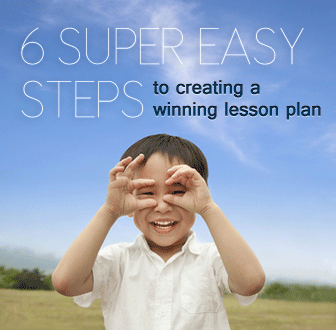Sounds Like a Plan: 7 Simple Steps to a Fantastic Lesson Plan


We have books, standards, and standardized tests to which we often teach. Sometimes, though, we can become so overwhelmed with the material that we fail to make a careful plan for sharing it with our students. However, that can be the exception rather than the rule if you follow these super simple steps for creating a winning lesson plan!

Before you can make any kind of effective lesson plan, you have to know your students. What age are they? Why are they studying English? What is their current proficiency level? You may already know those answers, but ask yourself the less obvious questions, too. What learning styles do they lean toward? What topics interest them? What cultures are represented in your class? Also, keep in mind any students who may have additional or special needs during the lesson.
Officially, you should know your learning objectives. Put more simply, this means knowing what you hope to accomplish by the end of your lesson. Do you want your students to know a specific set of vocabulary or a new grammatical structure? Do you want your class to practice using the language they already know or be comfortable with a dialogue in a specific situation? These are the language specific objectives for your lesson. If you are teaching content, think about ways to tie it to reading, writing, listening and speaking for your English students. Always keep in mind your ultimate goal, and knowing where you plan to get by the end of the lesson will help you as you work your way through it.
What are the most important things your students should know from the lesson you are planning? What would you like them to know but can be cut if necessary? What extra bits of information would you like to present to the class but feel confident they are not essential to the lesson or for your students’ understanding? Decide the answers to these questions before you go into detail with your lesson plan. For example, in a speaking class learning a specific set of vocabulary may be secondary. Learning cultural nuances may be a third level priority. When you define your priorities at the start of your lesson planning, you can be sure that your students will learn what they need to learn by the end of your class.
Just like any good story, a good lesson plan needs a beginning, middle and end. Plan a way of introducing the subject that will get your students thinking about what they already know, making connections in the brain. Plan more than one activity to introduce and practice new material. As you do, note any vocabulary or grammatical structures or other language specifics your student will need to successfully accomplish the tasks and make plans to review them as necessary. Also, think about whether you will need more than one class period to cover all the material in your lesson. Finish by planning a closing element to your lesson in which your students review and apply the information they learned during class.
One of the hardest tasks for a new teacher is determining how much time a given activity will take. Often the activities we think will take the largest portion of a class period are over in a matter of minutes and those we expect our students to breeze through end up trapping them like so much muck and mire. Make sure you are ready for anything in your class by over planning activities for each lesson. It is easy to scrap an optional activity at the last minute if you run out of time but not as easy to add an activity when you have not planned for it. Be ready for anything, and after you present your lesson make note of how long you spent on each activity.
It is always beneficial to spend a few moments after a lesson evaluating how it went, but your evaluation does not have to be a complicated process. Take three colored pencils – green, yellow and red, for example – and mark up your plan. What was good? Underline it in green. What was bad? Underline this in red. Is there anything that could be improved? Underline this in yellow and make a few notes. This will not only help you the next time you go through the same material with a future class, it will help you plan upcoming lessons better for the class you have now!
Some may choose to include curriculum objectives as required by their administrations, and others may conduct their lessons from a skeletal outline. No matter where you fall in the spectrum of written plans, as long as you walk through these six points for lesson planning, both you and your students will have a positive experience with the material you present in class.
How much detail do you like to go into when making lesson plans?